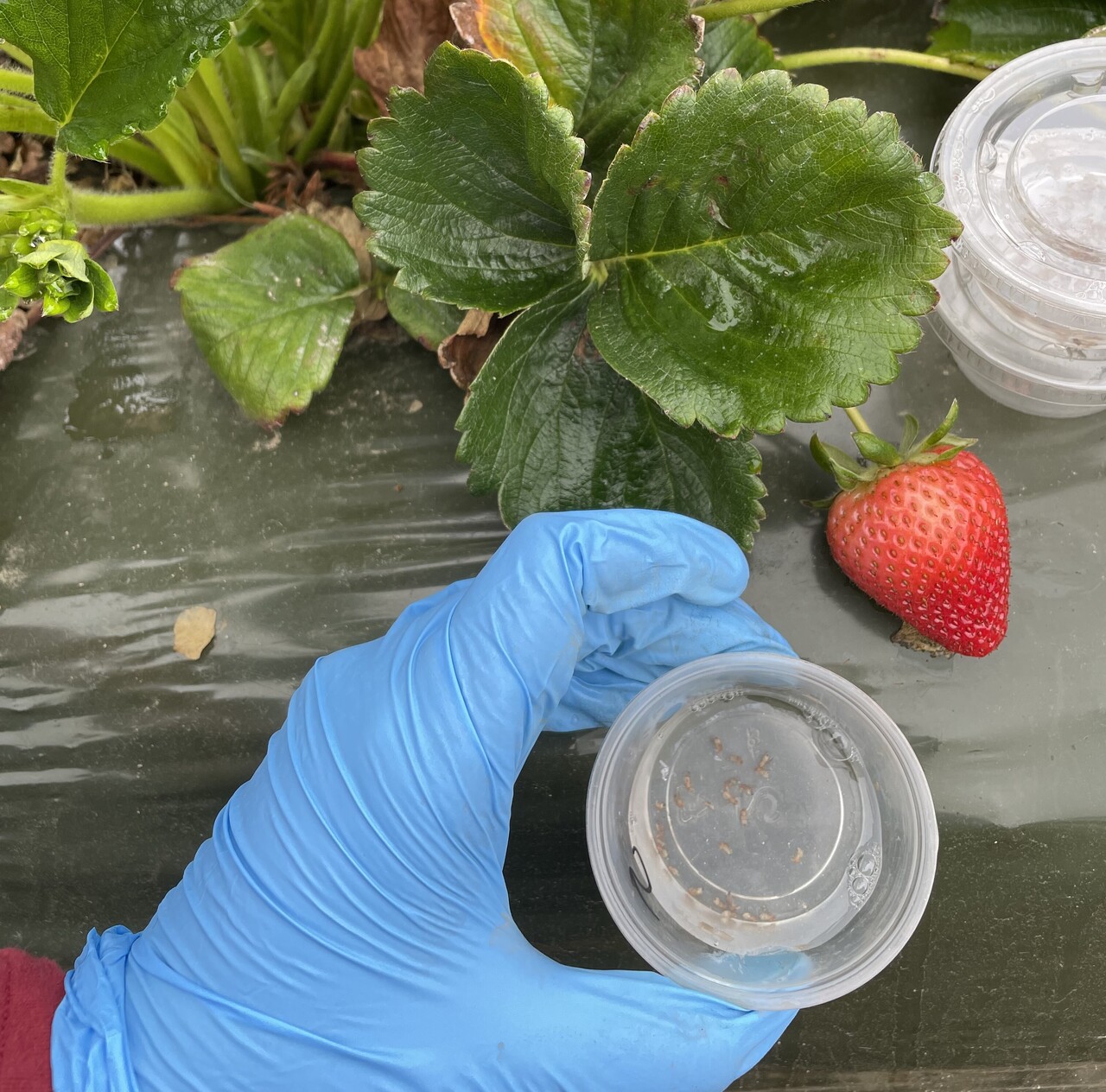


Spotted wing drosophila (SWD), Drosophila suzukii, is an invasive vinegar fly species native to East Asia. Since its arrival in California in 2008, SWD has spread across the major berry growing regions of North America. Growers with spotted wing drosophila pressure face significant economic losses due to its ability damage to fresh, market-ready fruit.
Characteristics of Spotted Wing Drosophila
Adult spotted wing drosophila are small, yellowish-brown flies with prominent red eyes. Males can be identified in the field by the dark spots on the tips of their wings. Females have a unique, serrated ovipositor (egg-laying organ) that allows them to deposit eggs into fresh, ripening fruit. This ability sets them apart from other Drosophila species that can only target soft, decomposing fruit.
SWD larvae develop inside the fruit, which causes wounds, collapse, and exposure to disease and other vinegar flies. Because females have the potential to lay hundreds of eggs over their lifespan, populations build quickly. Tolerance in the berry industry for SWD larvae is extremely low; during pre-market inspection, if one larva is found in one fruit clamshell, the entire pallet of fruit may be rejected.
SWD’s Impact on U.S. Berry Crops
Spotted wing drosophila is one of the most economically damaging pests of berries in the United States. Its ability to infest almost ripe, market ready fruit makes it especially destructive in commercial berry production. Key host crops (in order of least to highest affected) include:
Growers in temperate California berry-producing regions such as Watsonville, Santa Maria, and Oxnard report that spotted wing drosophila often requires weekly treatment throughout the season.
Integrated Pest Management for Spotted Wing Drosophila
 Photo: SWD trap collection, Celeste Torres, Suterra
Photo: SWD trap collection, Celeste Torres, Suterra
Monitoring
Pest monitoring is done throughout the growing season in various crop systems to support treatment decisions. Commercial berry growers typically use vinegar-based lures in jar traps to track adult spotted wing drosophila activity. Monitoring for SWD should begin early in the season, before fruit ripening and continue through harvest to identify areas with pest pressure. Although pressure varies year to year, monitoring may indicate areas of focus.
Cultural Practices
Cultural practices are tactics that alter the environment to make it less favorable for pests to establish. Common cultural practices within the berry system include properly timed harvests and sanitation. Harvesting as soon as fruit is viable means less time exposed to spotted wing drosophila populations. Removing cull fruit (fruit that does not meet quality standards) limits resources for SWD and other damaging vinegar fly species.
Chemical Controls
Chemical control is used often in different berry systems to manage spotted wing drosophila. If SWD has been identified, growers typically begin treatment early and continue a regular schedule until the end of the season. Because insecticide treatments occur frequently, it is crucial to rotate between different modes of action to slow resistance development.
BioMagnet™ Ruby
BioMagnet Ruby is a new, innovative attract and kill product developed specifically to target spotted wing drosophila in different berry systems. Unlike traditional insecticides, this platform treats the pest by drawing adult flies to a pouch treated with a powerful killing agent. This technology provides growers with an effective new tool in the fight against SWD. Resistant to weather and farm activities, the patented device allows for reduced insecticide use while improving control of the pest and slowing resistance to other chemical inputs.
Commitment to Sustainable Berry Protection
Spotted wing drosophila continues to challenge U.S. berry growers, driving up production costs and increasing the need for alternative integrated pest management tools. Understanding SWD biology and the importance of layered control strategies is essential for protecting fruit quality and marketability.
At Suterra, we’re committed to supporting sustainable berry production through innovative attract and kill technologies, such as BioMagnet Ruby.
Connect with an expert here to learn more about BioMagnet’s use in berry production.